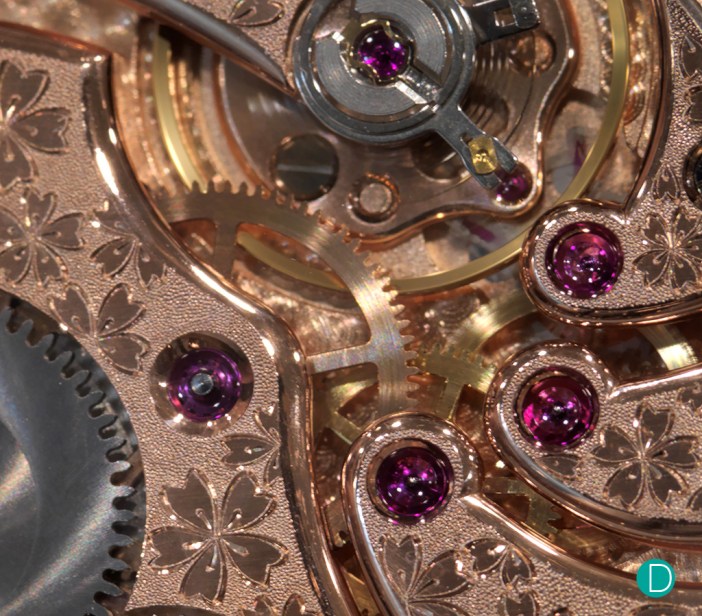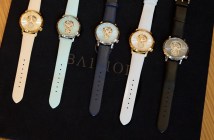Chances are, unless you are well versed in the Japanese independent watchmaking world, the name Daizoh Makihara does not strike a bell. But remember that name. We see great promise from this new watchmaker, and the magnificently beautiful work he has created. Here is a short introduction when the Cheif Editor visited and chatted with Daizoh about his creation.
Daizoh Makihara Kikutonagimon Sakura

Daizoh Makihara Kiku-tsunagi-mon sakura (菊繋ぎ紋桜), or “chrysanthemum pattern cherry blossoms”
Currently Daizoh has one watch on offer. The Kikutsunagimon sakura (菊繋ぎ紋桜), or “chrysanthemum link coat of arms and cherry blossoms” is a reflection on his thinking about combining vanishing Japanese craft with traditional watchmaking.

The kiku, or chrysanthemum flower is cut by hand using the Edo-kiriko method to form a chain mail of flowers. The dial material is glass quartz.
The chrysanthemum (kiku) is an important plant in Japan, the current Emperor sits on the Chrysantemum Throne. The flower blooms in autumn, and is seen as the collorary to the cherry blossoms (sakura) which blooms in spring. Daidoh has chosen the symbolism of kiku and sakura to also symbolise the seasons of autumn and spring.
The craftswoman responsible for making the dials is Noyuri Yamada, from Saiho.
The kiku pattern is shown in the dial using a special and ancient, swiftly vanishing technique called Edo-kiriko. Edo-kiriko is a traditional cut glass originating in Edo (the former name of Tokyo) toward the end of the Edo Period (1603-1868). Kiriko means “faceted” in Japanese, and refers to the multitude of decorative patterns that are engraved on the surface of the glass using grindstones and other tools. Using only rough outlines as guides, unlike the use of a Rose Engine for cutting guilloché where a template is used to cut the grooves, the kiriko artisans carve the detailed but accurate lines freehand.

The caseback.
And the sakura blossom is hand engraved on the movement which is visible through the sapphire case back. The technique is executed by Daizoh himself, and is made by hand engraving the pattern, polishing, and then hand hammering using a nail like tool to create the texture of the background which looks like tremblage. Also of note is the wide, exceptionally beautifully executed anglage on the bridges.

Detail, showing the hand engraved surfaces of the bridges. The bridge is engraved with the sakura flower motif by hand, and polished. The background is then hand hammered with a technique similar to tremblage. Note also the execution of the anglage on the bridge edges.
The base movement is a Unitas. The case is made by a case maker in Japan to Daizoh’s design, which reminds us of the case design used by A. Lange & Söhne. We mentioned that to Daizoh, and he let a sly smile indicating the affirmative. The lugs are soldered onto the case which is polished with a brushed band on the middle case. The rear bezel is screwed onto the back via 4 screws which is attached to the lugs.
Daizoh Makihara
Daizoh is currently Associate Professor of Watch Technology and Engraving at the Hiko Mizuno College of Jewelry, having previously trained and graduating in 2010 from the college as a Master Watchmaker. He teaches students to become watch technicians and the syllabus includes watch technology, metal processing, watch theory.

Daizoh Makihara, photographed in Tokyo. August 2018.
His work in the college occupies him three days a week, and he spends the rest of his time at his workshop making his own watch.

Daizoh’s home atelier where he does all the work.
Daizoh Makihara Kikutonagimon Sakura ”Chrysanthemum link coat of arm Cherry tree” Specifications and Price
・18k PG Case(Diameter42mm)
・Crocodile band (Buckle 18k PG)
・Sapphire glass
・Handwinding(Cal.DM01 )Unitas base
・17 jewels 18000bph
・3 Bar waterproof
Price: ¥4,900,000 or approximately US$50,000.





1 Comment
OK, first things first, this is genuinely a work of art. Whether you like it or hate it, this is what it is. To me it looks a tiny bit cheap, overly-ornate but not in a Breguet way. However, I assume that without the magnifying aspect of a camera, it will look very different and probably better. Culturally, it is also important. There are very few Japanese arts which have died out and if this one needs more exposure to be revived, then this watch has served an important purpose.
Secondly, this is not haute horlogerie.
Not even close.
Can those who write for this website PLEASE EDUCATE themselves, just a little bit?